Development of Three-Layered Composite Color Converters for White LEDs Based on the Epitaxial Structures of YAG:Ce, TbAG:Ce and LuAG:Ce Garnets
Abstract
1. Introduction
2. Materials and Methods
3. Results and Discussion
3.1. Structural Properties
3.2. Absorption and Photoluminescent Properties of Epitaxial Structures
3.3. Photoconversion Properties
4. Conclusions
Author Contributions
Funding
Institutional Review Board Statement
Informed Consent Statement
Data Availability Statement
Conflicts of Interest
References
- Schubert, E.F.; Kim, J.K. Solid-State Light Sources Getting Smart. Science 2005, 308, 1274–1278. [Google Scholar] [CrossRef] [PubMed]
- Nakamura, S. The Roles of Structural Imperfections in InGaN-Based Blue Light-Emitting Diodes and Laser Diodes. Science 1998, 281, 955–961. [Google Scholar] [CrossRef] [PubMed]
- Park, B.K.; Park, H.K.; Oh, J.H.; Oh, J.R.; Do, Y.R. Selecting Morphology of Y3Al5O12:Ce3+ Phosphors for Minimizing Scattering Loss in the Pc-LED Package. J. Electrochem. Soc. 2012, 159, J96–J106. [Google Scholar] [CrossRef]
- Sheu, J.K.; Chang, S.J.; Kuo, C.H.; Su, Y.K.; Wu, L.W.; Lin, Y.C.; Lai, W.C.; Tsai, J.M.; Chi, G.C.; Wu, R.K. White-Light Emission from near UV InGaN-GaN LED Chip Precoated with Blue/Green/Red Phosphors. IEEE Photonics Technol. Lett. 2003, 15, 18–20. [Google Scholar] [CrossRef]
- Light-Emitting Diodes: Research, Manufacturing, and Applications. Available online: https://spie.org/Publications/Proceedings/Volume/3002?end_volume_number=3099&SSO=1 (accessed on 12 January 2023).
- Blasse, G.; Bril, A. A new phosphor for flying-spot cathode-ray tubes for color television: Yellow-emitting Y3Al5O12–Ce3+. Appl. Phys. Lett. 1967, 11, 53–55. [Google Scholar] [CrossRef]
- Kottaisamy, M.; Thiyagarajan, P.; Mishra, J.; Ramachandra Rao, M.S. Color Tuning of Y3Al5O12:Ce Phosphor and Their Blend for White LEDs. Mater. Res. Bull. 2008, 43, 1657–1663. [Google Scholar] [CrossRef]
- Pimputkar, S.; Speck, J.S.; DenBaars, S.P.; Nakamura, S. Prospects for LED Lighting. Nat. Photonics 2009, 3, 180–182. [Google Scholar] [CrossRef]
- Bierhuizen, S.; Krames, M.; Harbers, G.; Weijers, G. Performance and Trends of High Power Light Emitting Diodes. In Proceedings of the Seventh International Conference on Solid State Lighting, San Diego, CA, USA, 26–30 August 2007; Ferguson, I.T., Narendran, N., Taguchi, T., Ashdown, I.E., Eds.; SPIE: Bellingham, WA, USA, 2007. [Google Scholar]
- Kim, Y.H.; Viswanath, N.S.M.; Unithrattil, S.; Kim, H.J.; Im, W.B. Review—Phosphor Plates for High-Power LED Applications: Challenges and Opportunities toward Perfect Lighting. ECS J. Solid State Sci. Technol. 2018, 7, R3134–R3147. [Google Scholar] [CrossRef]
- Bachmann, V.; Ronda, C.; Meijerink, A. Temperature Quenching of Yellow Ce3+ Luminescence in YAG:Ce. Chem. Mater. 2009, 21, 2077–2084. [Google Scholar] [CrossRef]
- Krames, M.R.; Shchekin, O.B.; Mueller-Mach, R.; Mueller, G.O.; Zhou, L.; Harbers, G.; Craford, M.G. Status and Future of High-Power Light-Emitting Diodes for Solid-State Lighting. J. Disp. Technol. 2007, 3, 160–175. [Google Scholar] [CrossRef]
- Wei, N.; Lu, T.; Li, F.; Zhang, W.; Ma, B.; Lu, Z.; Qi, J. Transparent Ce:Y3Al5O12 Ceramic Phosphors for White Light-Emitting Diodes. Appl. Phys. Lett. 2012, 101, 061902. [Google Scholar] [CrossRef]
- Arjoca, S.; Víllora, E.G.; Inomata, D.; Aoki, K.; Sugahara, Y.; Shimamura, K. Temperature Dependence of Ce:YAG Single-Crystal Phosphors for High-Brightness White LEDs/LDs. Mater. Res. Express 2015, 2, 055503. [Google Scholar] [CrossRef]
- Li, G.; Tian, Y.; Zhao, Y.; Lin, J. Recent Progress in Luminescence Tuning of Ce3+ and Eu2+-Activated Phosphors for Pc-WLEDs. Chem. Soc. Rev. 2015, 44, 8688–8713. [Google Scholar] [CrossRef] [PubMed]
- Xia, Z.; Meijerink, A. Ce3+-Doped Garnet Phosphors: Composition Modification, Luminescence Properties and Applications. Chem. Soc. Rev. 2017, 46, 275–299. [Google Scholar] [CrossRef]
- Ivanovskikh, K.V.; Ogiegło, J.M.; Zych, A.; Ronda, C.R.; Meijerink, A. Luminescence Temperature Quenching for Ce3+ and Pr3+ d-F Emission in YAG and LuAG. ECS J. Solid State Sci. Technol. 2013, 2, R3148–R3152. [Google Scholar] [CrossRef]
- Chao, W.-H.; Wu, R.-J.; Wu, T.-B. Structural and Luminescent Properties of YAG:Ce Thin Film Phosphor. J. Alloys Compd. 2010, 506, 98–102. [Google Scholar] [CrossRef]
- Hsu, C.T.; Yen, S.K. Electrochemical Synthesis of Thin Film YAG on Inconel Substrate. Electrochem. Solid State Lett. 2006, 9, D9. [Google Scholar] [CrossRef]
- Lee, Y.K.; Oh, J.R.; Do, Y.R. Enhanced Extraction Efficiency of Y2O3:Eu3+ Thin-Film Phosphors Coated with Hexagonally Close-Packed Polystyrene Nanosphere Monolayers. Appl. Phys. Lett. 2007, 91, 041907. [Google Scholar] [CrossRef]
- Bai, G.R.; Chang, H.L.M.; Foster, C.M. Preparation of Single-crystal Y3Al5O12 Thin Film by Metalorganic Chemical Vapor Deposition. Appl. Phys. Lett. 1994, 64, 1777, Erratum in Appl. Phys. Lett. 1994, 65, 790–790. [Google Scholar] [CrossRef]
- Díaz-Torres, L.A.; De la Rosa, E.; Salas, P.; Angeles-Chavez, C.; Arenas, L.B.; Nieto, J. Nanoparticle Thin Films of Nanocrystalline YAG by Pulsed Laser Deposition. Opt. Mater. 2005, 27, 1217–1220. [Google Scholar] [CrossRef]
- Zorenko, Y.; Gorbenko, V.; Savchyn, V.; Voznyak, T.; Sidletskiy, O.; Grinyov, B.; Nikl, M.; Mares, J.; Martin, T.; Douissard, P.-A. Single Crystalline Film Scintillators Based on the Orthosilicate, Perovskite and Garnet Compounds. IEEE Trans. Nucl. Sci. 2012, 59, 2260–2268. [Google Scholar] [CrossRef]
- Mauk, M.G. Liquid Phase Epitaxy for Light Emitting Diodes. In Liquid Phase Epitaxy of Electronic, Optical and Optoelectronic Materials; John Wiley & Sons, Ltd.: Chichester, UK, 2007; pp. 415–433. ISBN 9780470319505. [Google Scholar]
- Capper, P.; Mauk, M. (Eds.) Liquid Phase Epitaxy of Electronic, Optical and Optoelectronic Materials; John Wiley & Sons, Ltd.: Chichester, UK, 2007. [Google Scholar]
- Kundaliya, D.; Raukas, M.; Scotch, A.M.; Hamby, D.; Mishra, K.; Stough, M. Wavelength Converter for an LED and LED Containing Same. U.S. Patent No. 8,937,332 B2, 20 January 2015. [Google Scholar]
- Markovskyi, A.; Gorbenko, V.; Zorenko, T.; Yokosawa, T.; Will, J.; Spiecker, E.; Batentschuk, M.; Elia, J.; Fedorov, A.; Zorenko, Y. LPE Growth of Tb3Al5O12:Ce Single Crystalline Film Converters for WLED Application. CrystEngComm 2021, 23, 3212–3219. [Google Scholar] [CrossRef]
- Markovskyi, A.; Gorbenko, V.; Zorenko, T.; Nizhankovskiy, S.; Fedorov, A.; Zorenko, Y. Composite Color Converters Based on Tb3Al5O12: Ce Single-crystalline Films and Y3Al5O12: Ce Crystal Substrates. Phys. Status Solidi Rapid Res. Lett. 2021, 15, 2100173. [Google Scholar] [CrossRef]
- Witkiewicz-Lukaszek, S.; Gorbenko, V.; Zorenko, T.; Syrotych, Y.; Mares, J.A.; Nikl, M.; Sidletskiy, O.; Bilski, P.; Yoshikawa, A.; Zorenko, Y. Composite Detectors Based on Single-Crystalline Films and Single Crystals of Garnet Compounds. Materials 2022, 15, 1249. [Google Scholar] [CrossRef]
- Vegard, L. Die Konstitution der Mischkristalle und die Raumfllung der Atome. Eur. Phys. J. A 1921, 5, 17–26. [Google Scholar] [CrossRef]
- Zorenko, Y.; Gorbenko, V. Growth Peculiarities of the (Lu, Yb, Tb, Eu–Y) Single Crystalline Film Phosphors by Liquid Phase Epitaxy. Radiat. Meas. 2007, 42, 907–910. [Google Scholar] [CrossRef]
- Available online: http://abulafia.mt.ic.ac.uk/shannon/ptable.php (accessed on 30 October 2022).
- Asami, K.; Ueda, J.; Kitaura, M.; Tanabe, S. Investigation of Luminescence Quenching and Persistent Luminescence in Ce3+ Doped (Gd,Y)3(Al,Ga)5O12 Garnet Using Vacuum Referred Binding Energy Diagram. J. Lumin. 2018, 198, 418–426. [Google Scholar] [CrossRef]
- Yadav, P.J.; Joshi, C.P.; Moharil, S.V. Two Phosphor Converted White LED with Improved CRI. J. Lumin. 2013, 136, 1–4. [Google Scholar] [CrossRef]
- Zorenko, Y.; Gorbenko, V.; Konstankevych, I.; Voloshinovskii, A.; Stryganyuk, G.; Mikhailin, V.; Kolobanov, V.; Spassky, D. Single-Crystalline Films of Ce-Doped YAG and LuAG Phosphors: Advantages over Bulk Crystals Analogues. J. Lumin. 2005, 114, 85–94. [Google Scholar] [CrossRef]
- Nikl, M.; Mihokova, E.; Pejchal, J.; Vedda, A.; Zorenko, Y.; Nejezchleb, K. The Antisite LuAl Defect-Related Trap in Lu3Al5O12:Ce Single Crystal. Phys. Status Solidi B Basic Res. 2005, 242, R119–R121. [Google Scholar] [CrossRef]
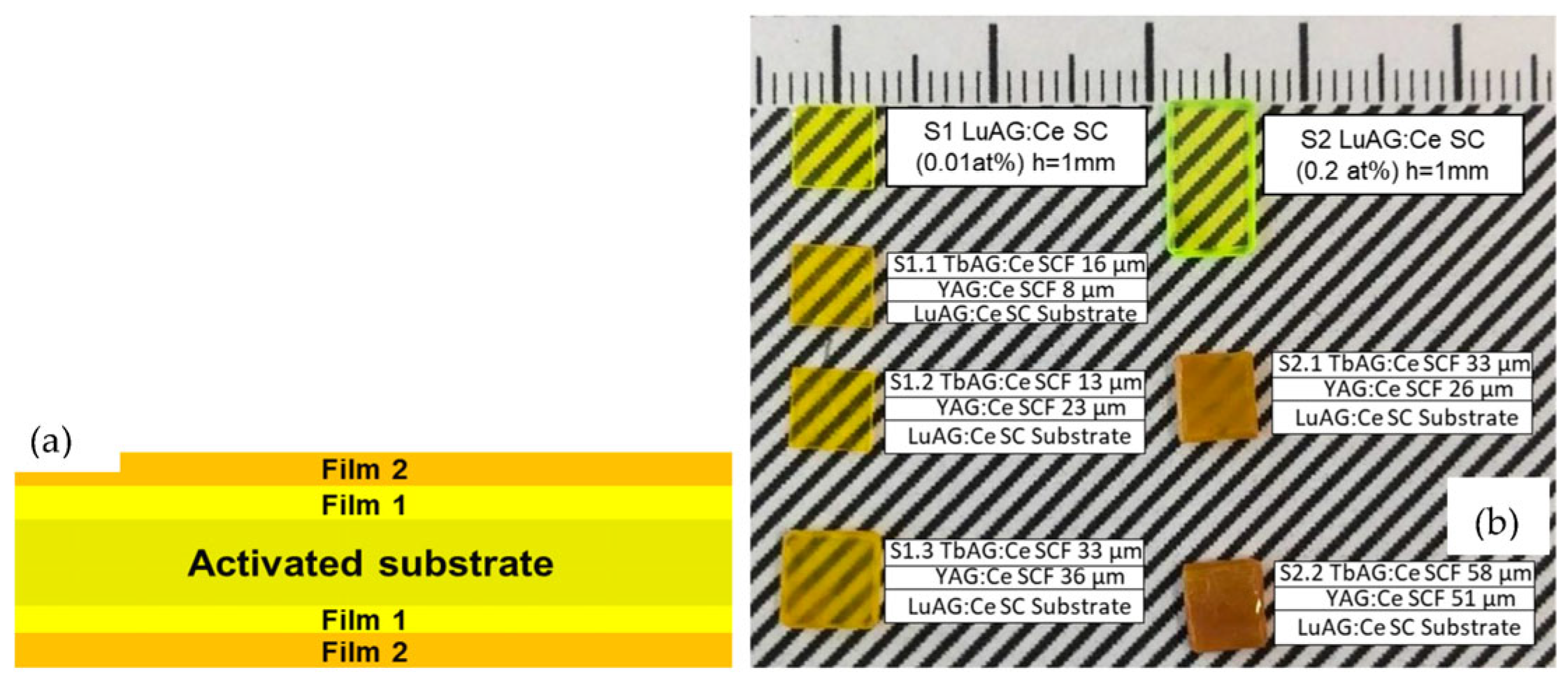
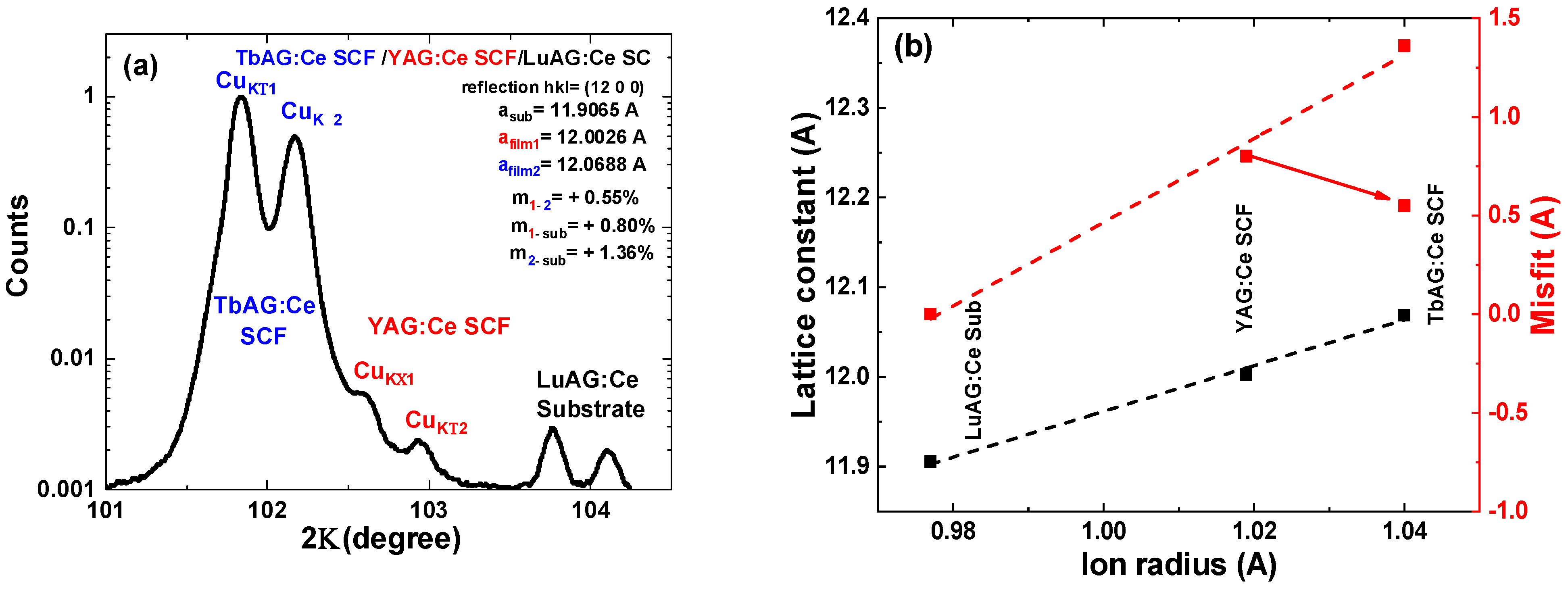
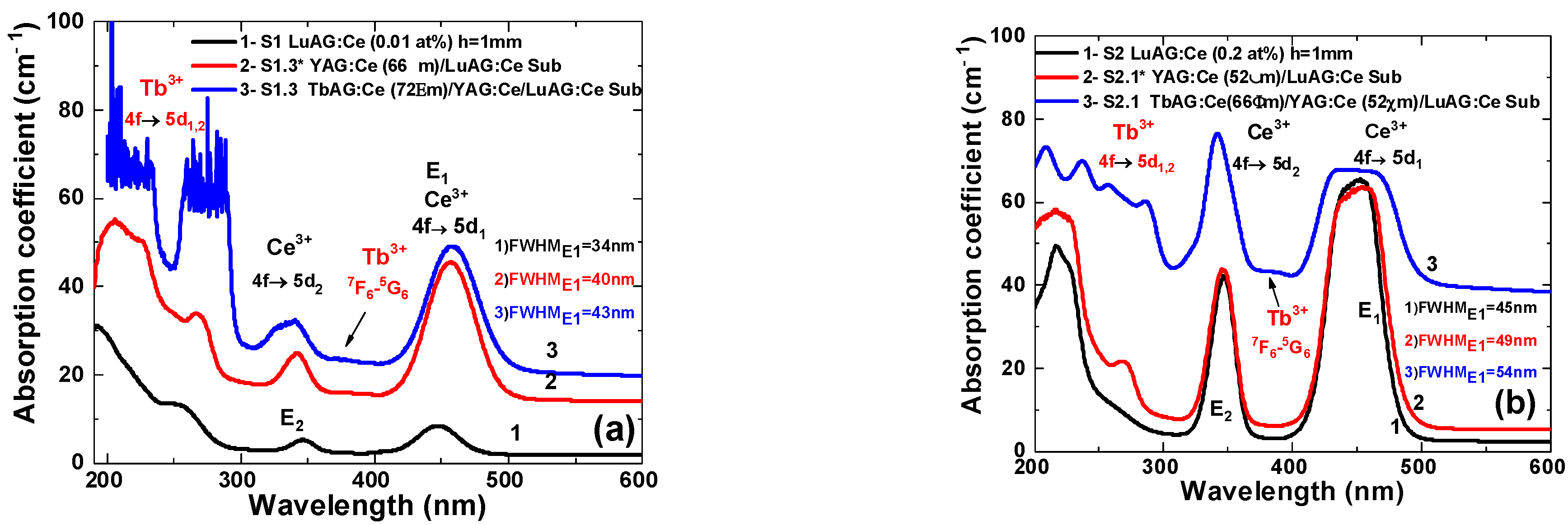
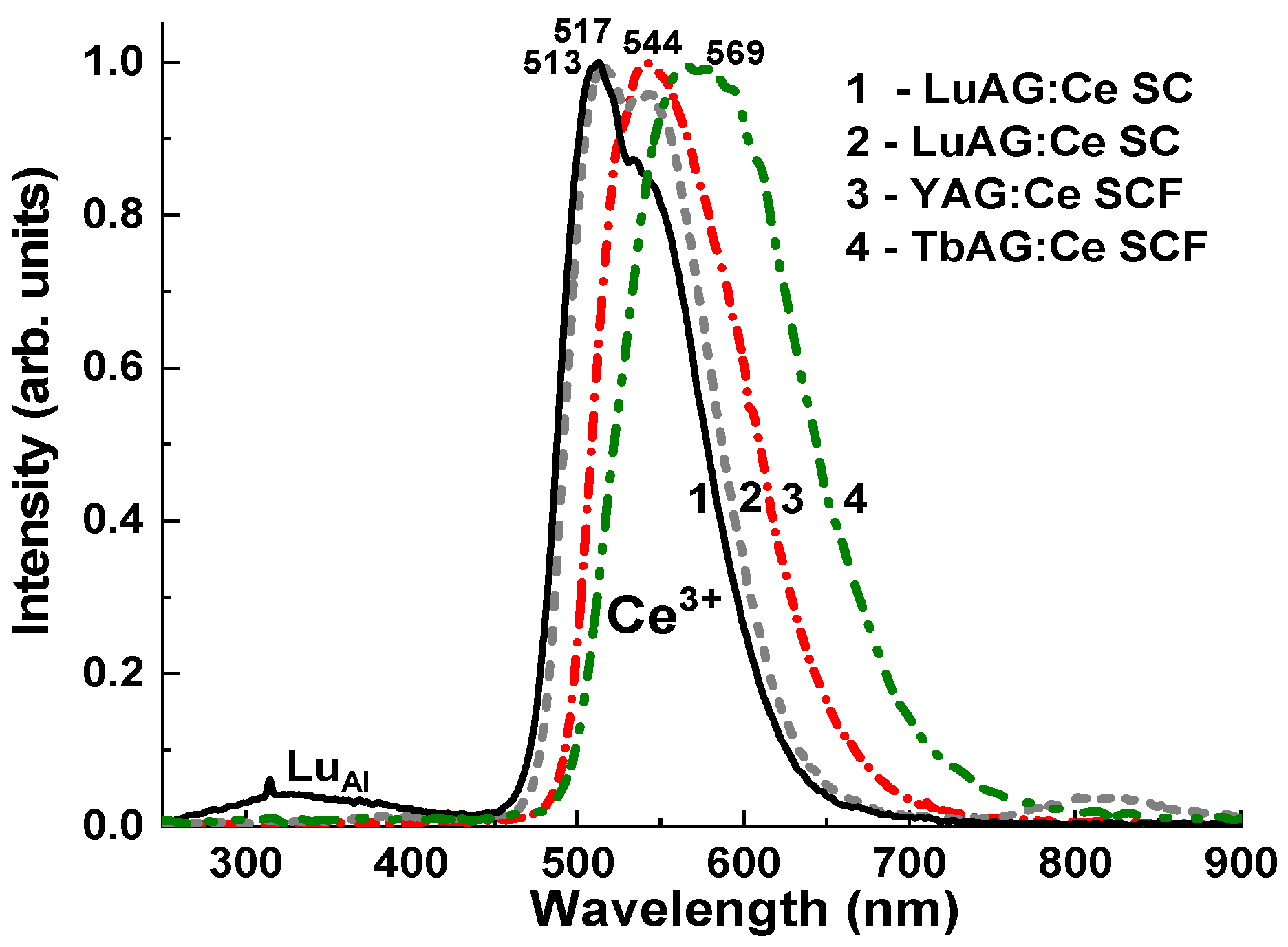
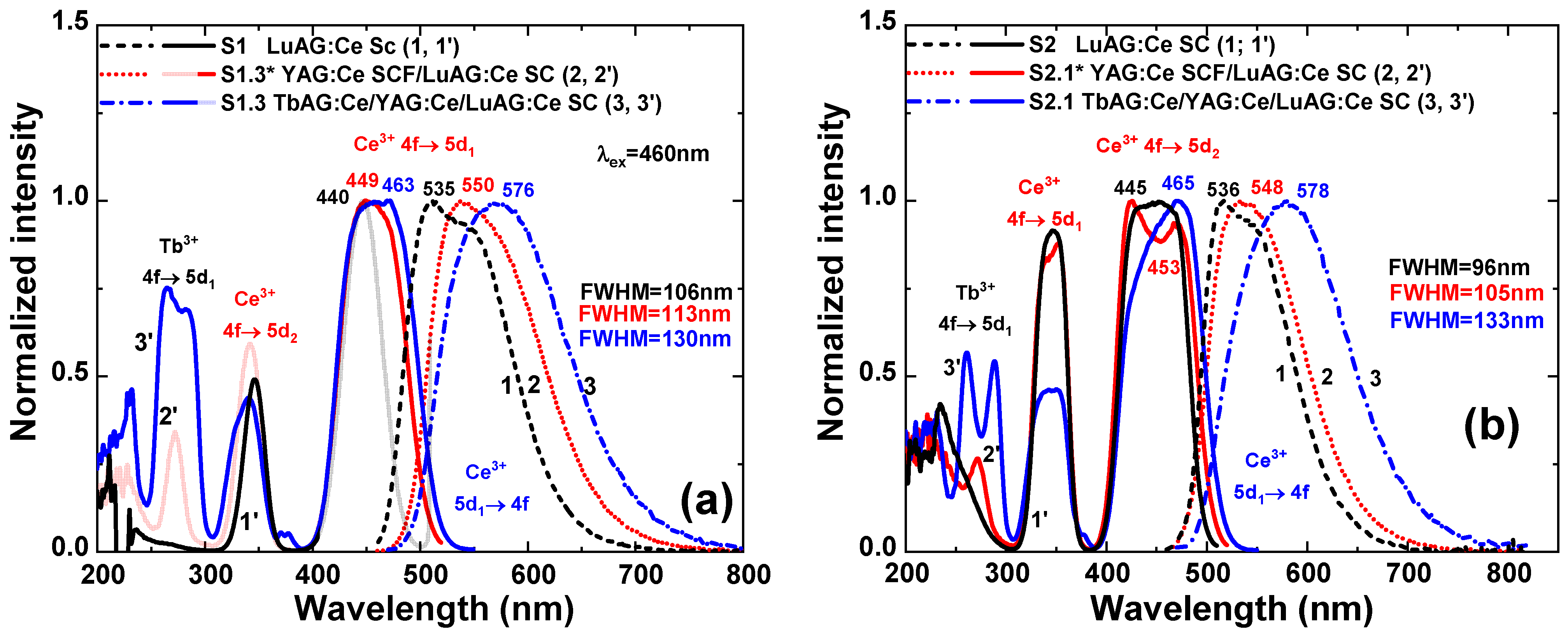
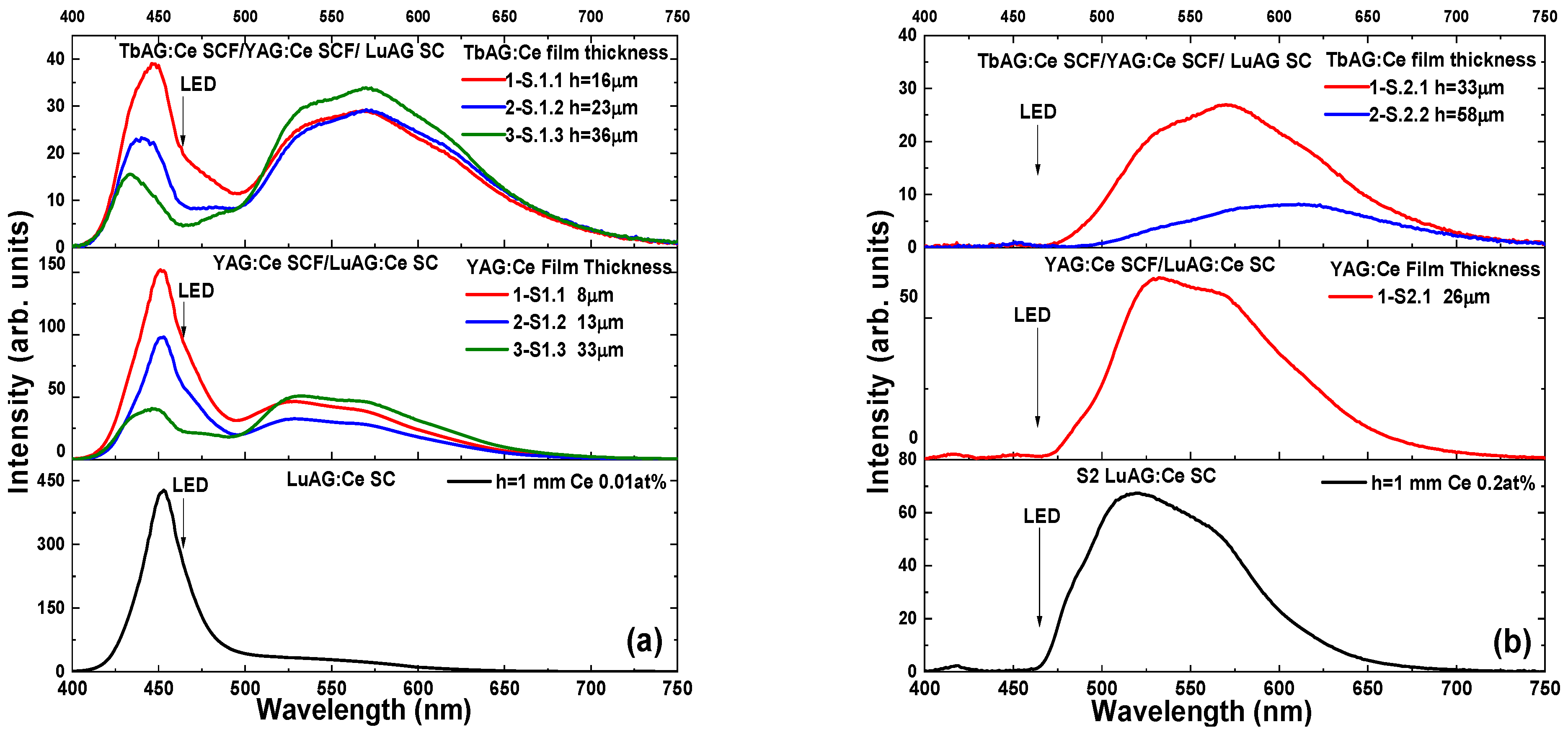
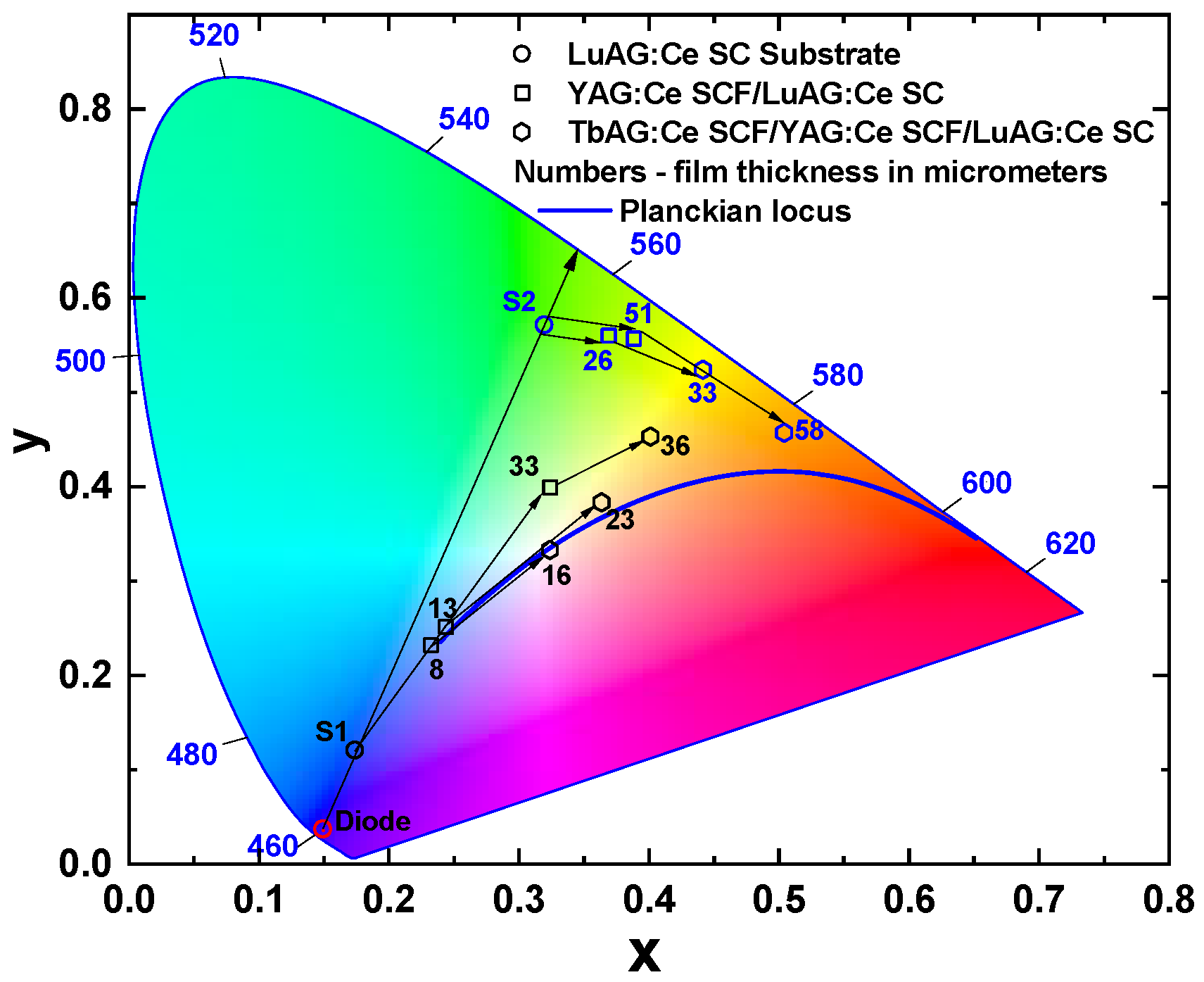
| Composition | Ionic Radius CN = 8, Ǻ | Lattice Constant, Ǻ | Misfit, % |
|---|---|---|---|
| LuAG:Ce SC substrate | 0.977 | 11.9065 | - |
| YAG:Ce SCF | 1.019 | 12.0026 | 0.8 |
| TbAG:Ce SCF | 1.04 | 12.0688 | 0.55 |
| Sample | Film h, µm | x | y | CCT, K | CRI |
|---|---|---|---|---|---|
| LuAG:Ce SC substrate | |||||
| S1. | 0 | 0.170 | 0.104 | N/A | N/A |
| YAG:Ce SCF/LuAG:Ce SC □ | |||||
| S1.1* | 8 | 0.232 | 0.232 | N/A | N/A |
| S1.2* | 13 | 0.244 | 0.251 | N/A | N/A |
| S1.3* | 33 | 0.322 | 0.394 | 5839 | 65 |
| TbAG:Ce SCF/YAG:Ce SCF/LuAG:Ce SC ⬢ | |||||
| S1.1 | 16 | 0.325 | 0.333 | 5852 | 77 |
| S1.2 | 23 | 0.369 | 0.388 | 4375 | 71 |
| S1.3 | 36 | 0.397 | 0.446 | 4032 | 66 |
| Sample | Film h, µm | x | y | CCT, K | CRI |
|---|---|---|---|---|---|
| LuAG:Ce SC substrate | |||||
| S2 | 0 | 0.319 | 0.571 | N/A | 27 |
| YAG:Ce SCF/LuAG:Ce SC □ | |||||
| S2.1* | 26 | N/A | N/A | N/A | N/A |
| S2.2* | 51 | 0.391 | 0.556 | N/A | 39 |
| TbAG:Ce SCF/YAG:Ce SCF/LuAG:Ce SC ⬢ | |||||
| S2.1 | 33 | 0.442 | 0.523 | 3672 | 51 |
| S2.2 | 58 | 0.504 | 0.456 | 2480 | 71 |
Disclaimer/Publisher’s Note: The statements, opinions and data contained in all publications are solely those of the individual author(s) and contributor(s) and not of MDPI and/or the editor(s). MDPI and/or the editor(s) disclaim responsibility for any injury to people or property resulting from any ideas, methods, instructions or products referred to in the content. |
© 2023 by the authors. Licensee MDPI, Basel, Switzerland. This article is an open access article distributed under the terms and conditions of the Creative Commons Attribution (CC BY) license (https://creativecommons.org/licenses/by/4.0/).
Share and Cite
Markovskyi, A.; Gorbenko, V.; Zorenko, T.; Witkiewicz-Lukaszek, S.; Sidletskiy, O.; Fedorov, A.; Zorenko, Y. Development of Three-Layered Composite Color Converters for White LEDs Based on the Epitaxial Structures of YAG:Ce, TbAG:Ce and LuAG:Ce Garnets. Materials 2023, 16, 1848. https://doi.org/10.3390/ma16051848
Markovskyi A, Gorbenko V, Zorenko T, Witkiewicz-Lukaszek S, Sidletskiy O, Fedorov A, Zorenko Y. Development of Three-Layered Composite Color Converters for White LEDs Based on the Epitaxial Structures of YAG:Ce, TbAG:Ce and LuAG:Ce Garnets. Materials. 2023; 16(5):1848. https://doi.org/10.3390/ma16051848
Chicago/Turabian StyleMarkovskyi, Anton, Vitaliy Gorbenko, Tatiana Zorenko, Sandra Witkiewicz-Lukaszek, Oleg Sidletskiy, Alexander Fedorov, and Yuriy Zorenko. 2023. "Development of Three-Layered Composite Color Converters for White LEDs Based on the Epitaxial Structures of YAG:Ce, TbAG:Ce and LuAG:Ce Garnets" Materials 16, no. 5: 1848. https://doi.org/10.3390/ma16051848
APA StyleMarkovskyi, A., Gorbenko, V., Zorenko, T., Witkiewicz-Lukaszek, S., Sidletskiy, O., Fedorov, A., & Zorenko, Y. (2023). Development of Three-Layered Composite Color Converters for White LEDs Based on the Epitaxial Structures of YAG:Ce, TbAG:Ce and LuAG:Ce Garnets. Materials, 16(5), 1848. https://doi.org/10.3390/ma16051848







